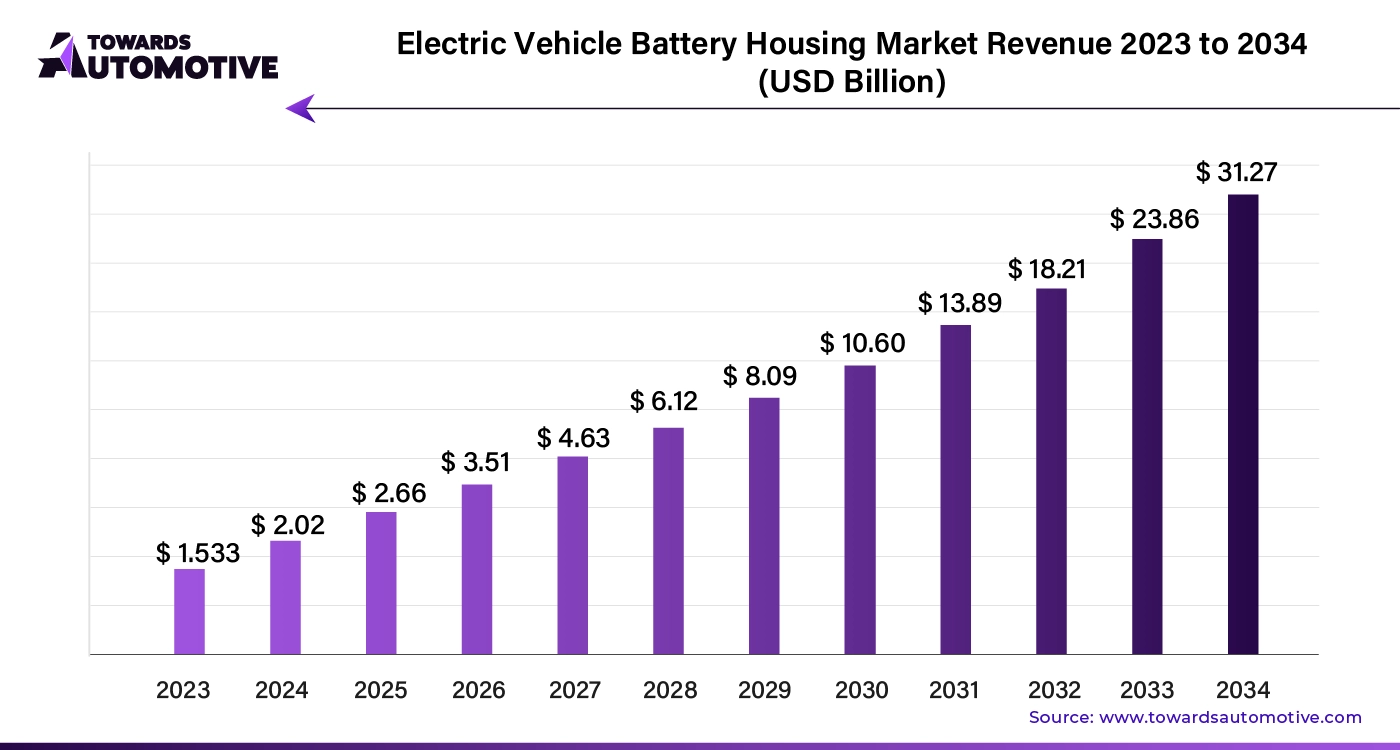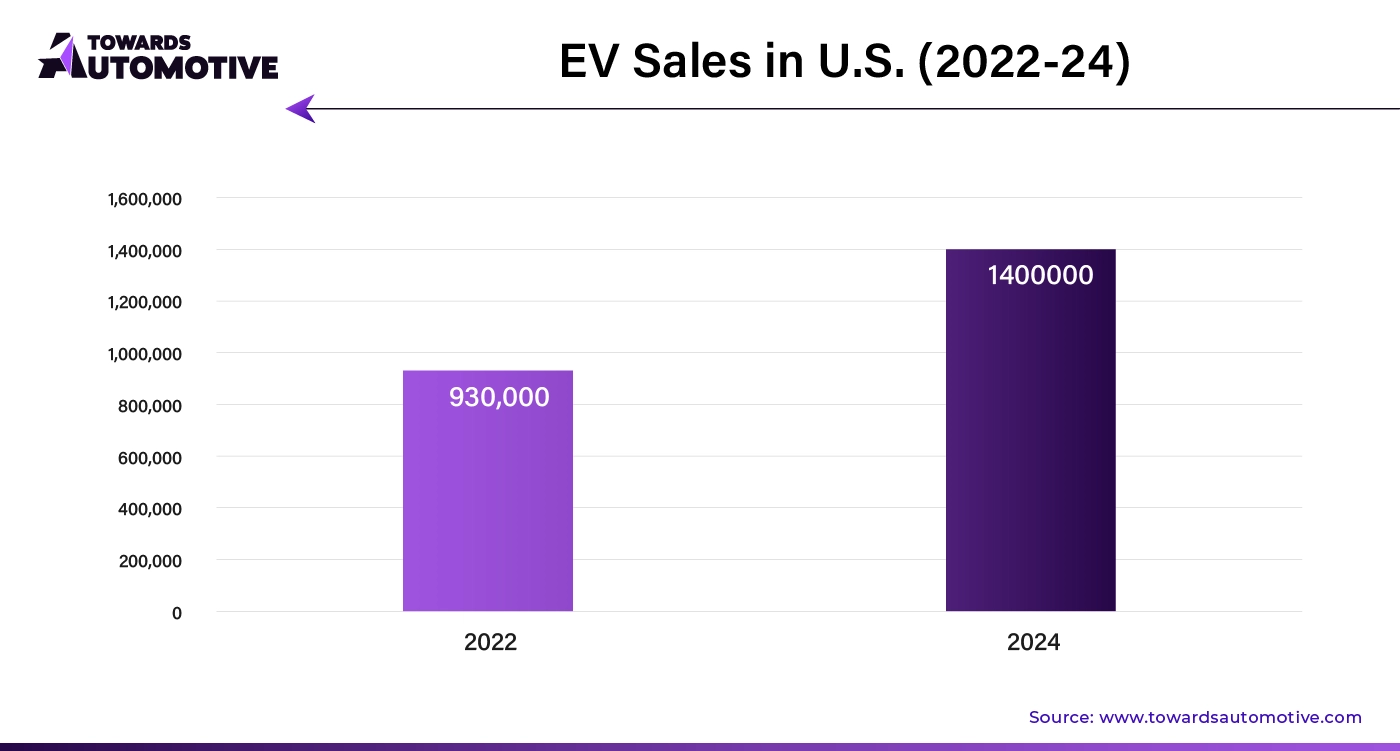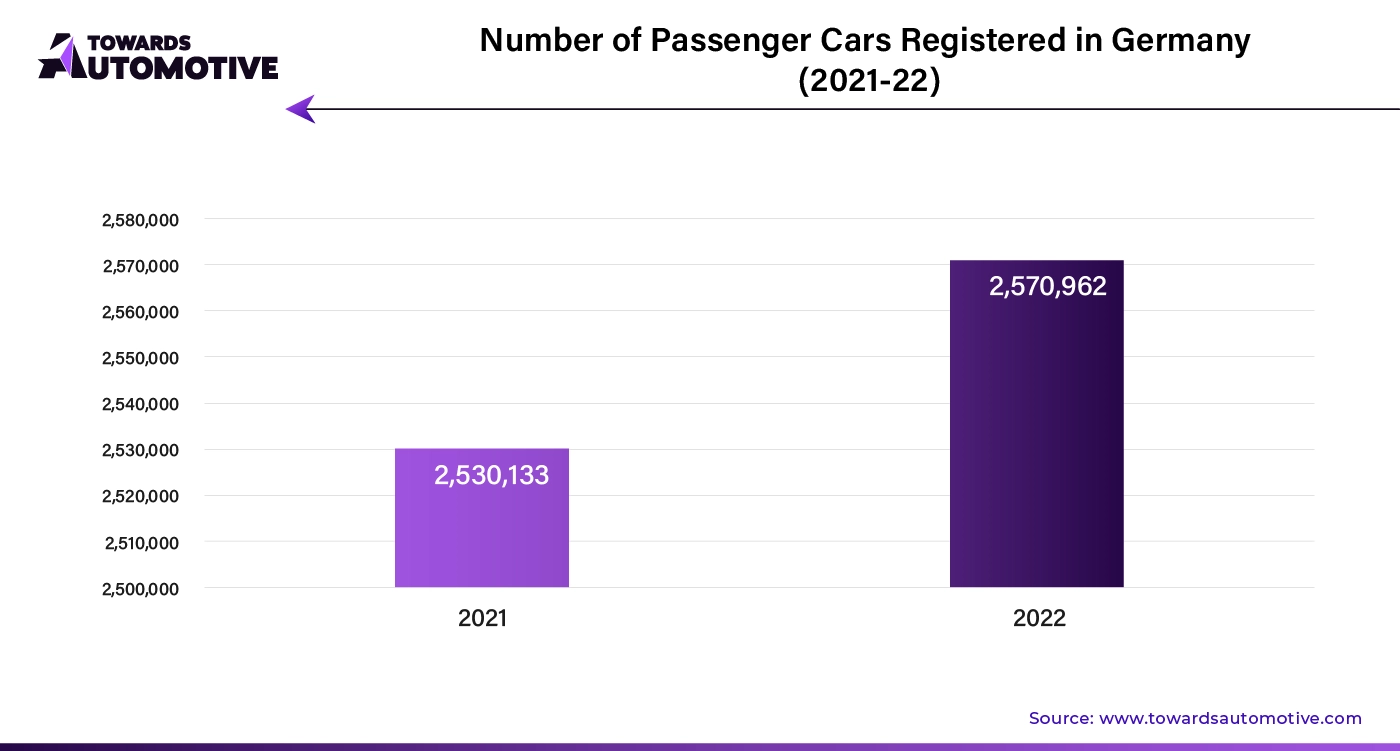April 2025
The global electric vehicle battery housing market size is calculated at USD 2.02 billion in 2024 and is expected to reach around USD 31.27 billion by 2034, growing at a CAGR of 31.84% from 2024 to 2034.

Unlock Infinite Advantages: Subscribe to Annual Membership
The electric vehicle battery housing market is expanding rapidly as the global shift toward sustainable transportation accelerates. Battery housing units play a crucial role in protecting and optimizing the performance of EV batteries, which are essential for powering electric drivetrains. These housings are designed to provide structural support, thermal management, and safety for battery packs, ensuring that they operate efficiently and reliably under various conditions. As electric vehicles gain popularity due to environmental regulations and consumer demand for greener alternatives, the need for advanced battery housing solutions grows.
Technological advancements are driving innovation in this market, with manufacturers developing lightweight, durable materials that enhance battery performance and safety. Improved thermal management systems within battery housings help maintain optimal operating temperatures, extending battery life and ensuring consistent power output. Additionally, the increasing complexity of battery designs, driven by advancements in energy density and range, requires sophisticated housing solutions to accommodate new technologies. The expansion of EV infrastructure and ongoing investment in research and development further support the growth of the electric vehicle battery housing market, making it a key component in the future of electric mobility.
Artificial intelligence (AI) plays a transformative role in the electric vehicle (EV) battery housing market by enhancing the design, manufacturing, and performance of battery enclosures. AI-driven simulations and modeling enable engineers to optimize the structural design and thermal management of battery housings. By analyzing vast amounts of data, AI can predict how different materials and designs will perform under various conditions, leading to the development of more efficient and durable housings that improve overall battery performance and safety.
In manufacturing, AI-powered automation streamlines production processes, increasing precision and reducing errors. Machine learning algorithms also facilitate predictive maintenance by analyzing performance data to identify potential issues before they lead to failures, thus extending the lifespan of battery housings and improving vehicle reliability.
Additionally, AI supports the integration of advanced materials and cooling systems into battery housings. These innovations enhance thermal management, crucial for maintaining optimal battery temperatures and ensuring consistent power output. As EV technology evolves, AI's role in advancing battery housing solutions becomes increasingly vital, driving innovation and supporting the growth of the electric vehicle battery housing market.
The rising demand for electric vehicles (EVs) is significantly driving the growth of the electric vehicle battery housing market. As more consumers and governments embrace electric mobility due to environmental concerns and regulatory incentives, the need for reliable and efficient battery solutions intensifies. Battery housings are crucial components that provide structural support, protection, and thermal management for EV batteries, which are essential for vehicle performance and safety.
The surge in EV adoption creates a growing market for advanced battery housings designed to accommodate increasingly powerful and complex battery packs. Manufacturers are responding by developing innovative housing solutions that enhance battery life, improve safety, and optimize thermal management. Advanced materials, such as lightweight composites and heat-resistant coatings, are being integrated into battery housings to meet the performance demands of modern electric drivetrains.
Furthermore, the expansion of EV infrastructure, including charging stations and service centers, supports this growth by facilitating broader adoption and maintenance of electric vehicles. As the electric vehicle market continues to expand, the demand for sophisticated battery housings rises, propelling innovation and growth in the electric vehicle battery housing market.

The electric vehicle (EV) battery housing market faces several restraints that impact its growth. High production costs associated with advanced materials and complex manufacturing processes can limit affordability and market accessibility. Additionally, the limited availability of certain high-performance materials can disrupt supply chains and increase costs. Regulatory hurdles and stringent safety standards also add to the complexity of designing and producing compliant battery housings. These factors collectively pose challenges to the expansion of the electric vehicle battery housing market.
Modular design is creating significant opportunities in the electric vehicle (EV) battery housing market by offering flexibility and adaptability in battery management. Modular battery housings allow for the easy assembly, disassembly, and replacement of individual battery modules, which simplifies maintenance and upgrades. This design approach supports the integration of evolving battery technologies and facilitates faster adaptation to new advancements, enabling manufacturers to keep pace with rapid technological changes.
The modular design also enhances scalability, allowing battery housings to be customized for various vehicle models and applications. This versatility not only improves manufacturing efficiency but also reduces production costs by enabling the use of standardized components across different vehicle types. Additionally, modular battery housings can contribute to better thermal management and safety, as individual modules can be optimized for cooling and protection.
Overall, modular designs support a more dynamic and responsive approach to battery housing, driving innovation and growth in the market. As electric vehicles continue to evolve and demand for advanced battery solutions increases, the modular approach provides a valuable pathway for meeting these needs effectively and efficiently.
The non-metallic segment dominated the market with a share of 47%. These housings, often made from advanced composites or high-strength plastics, provide several benefits that enhance vehicle performance and safety. Non-metallic materials are lightweight, which helps reduce the overall weight of the vehicle, leading to improved energy efficiency and extended driving range. Their superior thermal insulation properties also aid in maintaining optimal battery temperatures, enhancing performance and longevity.
Furthermore, non-metallic battery housings can be engineered to include advanced features such as integrated cooling channels and impact-resistant properties, which improve safety and reliability. The use of non-metallic materials also supports more flexible and innovative design approaches, allowing for complex shapes and forms that can better accommodate various battery configurations.
As automakers increasingly focus on reducing vehicle weight and improving energy efficiency, the demand for non-metallic battery housings is rising. This shift is fueling market growth by promoting the adoption of these advanced materials in the development of next-generation electric vehicles.
The passenger vehicles segment held the dominant share of the market. Passenger vehicles are driving substantial growth in the electric vehicle (EV) battery housing market by significantly increasing the demand for advanced battery enclosures. As the popularity of electric passenger cars rises due to environmental awareness and regulatory incentives, the need for efficient and durable battery housings becomes crucial. Battery housings protect and support the battery packs that power these vehicles, ensuring their safety and performance.
The growing consumer preference for electric passenger vehicles, driven by concerns over emissions and fuel efficiency, propels automakers to invest in high-quality battery housings that can accommodate larger and more powerful batteries. Innovations in battery housing design, such as improved thermal management and impact resistance, are being developed to meet the specific needs of passenger vehicles.
Additionally, as automakers strive to enhance the range and performance of electric passenger cars, the demand for advanced battery housings that support these objectives continues to grow. The expansion of the electric passenger vehicle market, therefore, directly fuels the development and adoption of sophisticated battery housing solutions, driving growth in the electric vehicle battery housing market.

United States held 9.5% share of the global market. There are several factors that is driving the expansion of the electric vehicle (EV) battery housing market in the USA. One of the primary drivers is the increasing adoption of electric vehicles, fueled by federal and state incentives aimed at reducing emissions and promoting clean energy. Government policies such as tax credits and subsidies for EV buyers and manufacturers boost demand for electric vehicles, thereby increasing the need for high-quality battery housings that provide safety and performance.
Technological advancements in battery technology are also contributing to market growth. As battery packs become more powerful and complex, there is a growing need for advanced battery housings that offer improved thermal management, structural integrity, and safety features. Innovations in materials, including lightweight composites and high-strength polymers, enhance the performance and durability of battery housings.
The expansion of EV infrastructure, such as charging stations and service centers, supports the growth of the EV market and indirectly drives demand for battery housings. Additionally, increased consumer awareness of environmental issues and the push for sustainable transportation solutions further accelerate the growth of the electric vehicle battery housing market in the USA.
Germany dominated the global electric vehicle battery housing market with a share of 11.5%. The electric vehicle (EV) battery housing market in Germany is experiencing notable growth due to several key factors. Germany's robust commitment to environmental sustainability and stringent emissions regulations are primary drivers, promoting the adoption of electric vehicles. Government initiatives, including subsidies and incentives for both EV buyers and manufacturers, stimulate demand for advanced battery solutions, thereby boosting the need for high-performance battery housings.
The country's strong automotive industry, known for its engineering excellence, is another crucial growth factor. German automakers are investing heavily in the development of innovative battery technologies, which necessitate sophisticated battery housings designed to accommodate advanced battery packs. These housings must provide superior thermal management, safety, and structural support to enhance vehicle performance and reliability.
Additionally, Germany's expanding EV infrastructure, such as widespread charging networks and state-of-the-art manufacturing facilities, supports the growth of the EV market and, consequently, the demand for battery housings. As consumer preference for electric vehicles continues to rise and technological advancements drive the industry forward, these factors collectively contribute to the robust growth of the electric vehicle battery housing market in Germany.
The United Kingdom is likely to grow with a CAGR of 28.4% during the forecast period. The electric vehicle (EV) battery housing market in the United Kingdom is growing rapidly due to several pivotal factors. Government policies aimed at reducing carbon emissions and promoting sustainable transportation play a significant role, with initiatives like the Road to Zero strategy and various grants encouraging the adoption of electric vehicles. These policies not only stimulate consumer demand but also drive investment in advanced battery technologies, increasing the need for high-quality battery housings.
The UK’s automotive sector, known for its innovation and technological prowess, is another key driver. British manufacturers are focusing on developing state-of-the-art battery housings that enhance performance, safety, and thermal management. As battery technologies advance, the demand for sophisticated housings that can accommodate new designs and materials grows.
Furthermore, the expansion of EV infrastructure, including widespread charging networks and dedicated service centers, supports market growth by facilitating the broader adoption of electric vehicles. With increasing public awareness of environmental issues and the push for greener solutions, these factors collectively drive the growth of the electric vehicle battery housing market in the United Kingdom.
India is expected to grow with a CAGR of 42.25% during the forecast period. The electric vehicle (EV) battery housing market in India is expanding rapidly due to several key growth factors. The Indian government's commitment to promoting electric mobility through initiatives like the Faster Adoption and Manufacturing of Hybrid and Electric Vehicles (FAME) scheme and various state-level subsidies plays a crucial role. These policies incentivize both consumers and manufacturers, driving up the demand for electric vehicles and, consequently, for high-quality battery housings.
The increasing focus on reducing urban air pollution and improving fuel efficiency further propels the adoption of EVs in India. As the market for electric vehicles grows, the need for advanced battery housings that offer robust thermal management, safety, and structural support becomes more pronounced. Innovations in materials and design are addressing these needs, with manufacturers developing solutions tailored to the unique demands of the Indian market.
China is anticipated to grow with a CAGR of 26.46% during the forecast period. The electric vehicle (EV) battery housing market in China is experiencing significant growth driven by several key factors. The Chinese government's strong support for electric mobility, including subsidies, tax incentives, and stringent emissions regulations, plays a major role. These policies encourage both consumers and manufacturers to adopt electric vehicles, thereby increasing the demand for advanced battery housings.
China’s leading position in the global EV market, with its large-scale production capabilities and rapid technological advancements, further fuels this growth. Chinese automakers are investing heavily in developing innovative battery technologies, which necessitate high-performance battery housings that provide superior thermal management, safety, and structural integrity. The demand for lightweight and durable materials in battery housings is rising as EV designs become more complex.
Moreover, the expansion of EV infrastructure, including a vast network of charging stations and improved manufacturing facilities, supports the broader adoption of electric vehicles. As consumer awareness of environmental issues grows and technology evolves, these factors collectively drive the robust growth of the electric vehicle battery housing market in China.
Japan held 1.2% share of the global electric vehicle battery housing market. The electric vehicle (EV) battery housing market in Japan is growing rapidly due to several influential factors. Japan's strong commitment to environmental sustainability and innovation significantly drives the demand for electric vehicles. Government policies, such as subsidies and incentives for EV purchases and stringent emissions regulations, create a supportive environment for the adoption of electric vehicles, thereby increasing the need for high-quality battery housings.
Japanese automakers, renowned for their technological advancements and engineering expertise, are at the forefront of developing cutting-edge battery technologies. This innovation fuels the demand for sophisticated battery housings that provide excellent thermal management, safety, and structural support. As vehicle designs become more advanced, the need for robust and efficient battery housings grows.
By Material
By Cell Format Type
By Application
By Region
April 2025
April 2025
April 2025
April 2025
We offer automotive expertise for market projections and customizable research, adaptable to diverse strategic approaches.
Contact Us